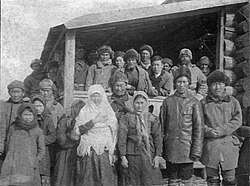Orang Evenk
kelompok etnik
Suku Evenk (juga disebut Ewenki atau Evenki) (otonim: Эвэнкил Evenkil; bahasa Rusia: Эвенки Evenki; Hanzi: 鄂温克族 Èwēnkè Zú; dulunya dikenal sebagai Tungus atau Tunguz; bahasa Mongolia: Хамниган Khamnigan) adalah sebuah suku bangsa Tungusik dari Asia Utara. Di Rusia, suku Evenk dianggap sebagai salah satu suku asli Rusia Utara, dengan populasi 38,396 (sensus tahun 2010). Di China, suku Evenki membentuk salah satu dari 56 kelompok etnis yang resmi diakui oleh Republik Rakyat China, dengan populasi 30,875 (sensus 2010).[2] Terdapat 537 orang Evenk, yang disebut Khamnigan dalam bahasa Mongolia, di Mongolia (sensus 2015).[10]
Эвэнкил | |
|---|---|
 Sebuah keluarga Evenk pada awal 1900-an | |
| Jumlah populasi | |
| 69,856[1][2][3][4] | |
| Daerah dengan populasi signifikan | |
| 38,396[1] | |
| 30,875[2] | |
| 537[5] | |
| 48[6] | |
| Bahasa | |
| Evenki, Rusia, Tionghoa | |
| Agama | |
| Shamanisme, Kristen Ortodoks, Buddha Tibetan[7][8][9] | |
| Kelompok etnik terkait | |
| Even, Manchu, Oroqen, Oroch | |
Referensi
- D. O. Chaoke (an Evenk), WANG Lizhen (2002). 鄂温克族宗教信仰与文化 (Zipped NLC (Modified JBIG)). Beijing: 中央民族大学. ISBN 978-7-81056-700-8.
- (The online edition needs a Book Reader for NLC[pranala nonaktif permanen] and a ZIP extractor)
- "Altaic." Columbia Electronic Encyclopedia. 6th ed. 2009. Academic Search Premier. EBSCO. Web. 4 Nov. 2009.
- Anderson, David G. "Is Siberian Reindeer Herding in Crisis? Living with Reindeer Fifteen Yearss after the End of State Socialism." Nomadic Peoples NS 10.2 (2006): 87-103. EBSCO. Web. 6 Nov. 2009.
- Bulatova, Nadezhda, and Lenore Grenoble. Evenki. Munchen: LINCOM Europa, 1999. Print. Languages of the World.
- "Evenki." Cassell's Peoples, Nations, and Cultures. Weidenfeld & Nicolson, 2005. EBSCO. Web. 4 Nov. 2009.
- "Evenki." Ethnologue: Languages of the World, Sixteenth Edition. Ed. Paul M. Lewis. SIL International, 2009. Web. 8 Dec. 2009.<http://www.ethnologue.com/show_language.asp?code=evn>.
- Fondahl, Gail. Gaining ground? Evenkis, land and reform in southeastern Siberia. Boston: Allyn and Bacon, 1998. Print.
- Forsyth, James. History of the Peoples of Siberia: Russia's North Asian Colony, 1581-1990. Cambridge: Cambridge UP, 1992. Print.
- Georg, Stefan, Peter A. Michalove, Alexis M. Ramer, and Paul J. Sidwell. "Telling general linguists about Altaic." Journal of Linguistics 35.1 (1999): 65-98. JSTOR. Web. 8 Dec. 2009.
- Hallen, Cynthia L. "A Brief Exploration of the Altaic Hypothesis." Department of Linguistics. Brigham Young University, 6 Sept. 1999. Web. 8 Dec. 2009.<http://linguistics.byu.edu/classes/ling450ch/reports/altaic.htm>.
- Janhunen, Juha. "Evenki." Interactive Atlas of the World's Languages in Danger. Ed. Christopher Moseley. UNESCO Culture Sector, 31 Mar. 2009. Web. 8 Dec. 2009.<https://web.archive.org/web/20090222090430/http://www.unesco.org/culture/ich/index.php?pg=00206>.
- Nedjalkov, Igor. Evenki. London: Routledge, 1997. Print. Descriptive Grammars.
- Sirina, Anna A. "People Who Feel the Land: The Ecological Ethic of the Evenki and Eveny." Trans. James E. Walker. Anthropology & Archaeology of Eurasia 3rd ser. 47.Winter 2008-9 (2009): 9-37. EBSCOHost. Web. 27 Nov. 2009.
- Vasilevich, G. M., and A. V. Smolyak. "Evenki." The Peoples of Siberia. Ed. Stephen Dunn. Trans. Scripta Technica, Inc. Chicago: The University of Chicago, 1964. 620-54. Print.
- Vitebsky, Piers. Reindeer people: Living with Animals and Spirits in Siberia. Boston: Houghton Mifflin, 2005. Print.
- Wood, Alan, and R. A. French, eds. Development of Siberia: People and Resources. New York: St. Martin's, 1989. Print.
Pranala luar
🔥 Top keywords: Liga Champions UEFAPiala Asia U-23 AFC 2024YandexAmicus curiaeHalaman UtamaDuckDuckGoIstimewa:PencarianFacebookTanda titik duaJepangManchester City F.C.TwitterReal Madrid C.F.KleopatraLiga Champions UEFA 2023–2024Kualifikasi Piala Asia U-23 AFC 2024FC Bayern MünchenBerkas:Youtube logo.pngYouTubeMinal 'Aidin wal-FaizinSiksa Kubur (film)Gunung RuangFC BarcelonaFree FireAhmad Muhdlor AliIndonesiaXXNXXIranCerezo OsakaBadarawuhi Di Desa PenariBaratPersija JakartaDubaiMadridInstagramTikTokAnjungan tunai mandiriTim nasional sepak bola Indonesia